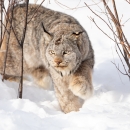The Yukon Flats is one of the most fire-prone regions of Alaska and is subject to repetitive but irregular, long-term cycles of burning and regeneration. The fire season in most years extends from late April through July.
Fire on the Yukon Flats is essential to maintaining healthy plant and wildlife communities. The Yukon Flats boreal forest is an excellent example of a fire-dependent ecosystem that experiences repetitive, long-term cycles of burning and regeneration. Disturbance by fire maintains a diversity of plant species by interrupting natural succession and preventing the landscape from being dominated by climax species. Fire drives the forest dynamics by removing competing vegetation and/or exposing mineral soil, increasing sunlight penetration, recycling nutrients, and generally creating favorably conditions for seeds and root-sprouts. The most common source of fire on the Yukon Flats is lightening. Combined with low precipitation, high summer temperatures, and the presence of highly flammable fuel, lightening commonly ignites wildland fires that can burn several hundred thousand acres at a time.
The most common source of fire on the Yukon Flats is lightning. The presence of highly flammable natural fuels combined with long summer days, high summer temperatures, and very little precipitations sometimes allows lightning to ignite wildfires fires that can burn several hundred thousand acres over a season.
Fire Management on the Refuge
Wildfire is a vital ecological component of boreal forests and will always be present. Therefore, the ongoing challenge for land management agencies is to manage fire in order to protect human values at risk while allowing fire to play its natural ecological role in maintaining a healthy ecosystem.
Refuge staff work with Alaska Fire Service, Doyon, Ltd. (the Native Regional Corporation), local tribal governments and state agencies to maintain a near-natural fire regime. Refuge lands are assigned fire-protection levels based on values to be protected, with human safety being the top priority in all fire management decisions. This management strategy reduces costs, keeps suppression forces available for high-priority areas, and helps maintain a more natural fire regime over much of the refuge. This increases habitat diversity and helps maintain plant community productivity.
The refuge includes the following fire protection zones:
- Critical and Full - 127,000 acres (less than 2%)
- Modified - 884,000 acres (about 10%)
- Limited - 7,589,000 acres (88%)
Critical Fire Management Option zones, which include villages, automatically receive the highest priority for fire suppression.
Full Management Option zones are situated around the Critical zones, and may include historic sites or other high-value resources. Fires in these zones are aggressively attacked and fought until the fire is declared out.
Modified Management Option zones often surround Full Management zones or may be designated for areas where large fires are not wanted early in the fire season. Fires in Modified zones are suppressed by fairly aggressive action early in the season, but later in the season (generally mid-July) may be treated like those occurring in Limited Management Option zones.
Limited Management Option zones, by comparison, are principally located in the more remote sections of the refuge, where values to be protected do not warrant the cost of aggressive suppression. Fires in Limited Zones are normally monitored but not suppressed.



